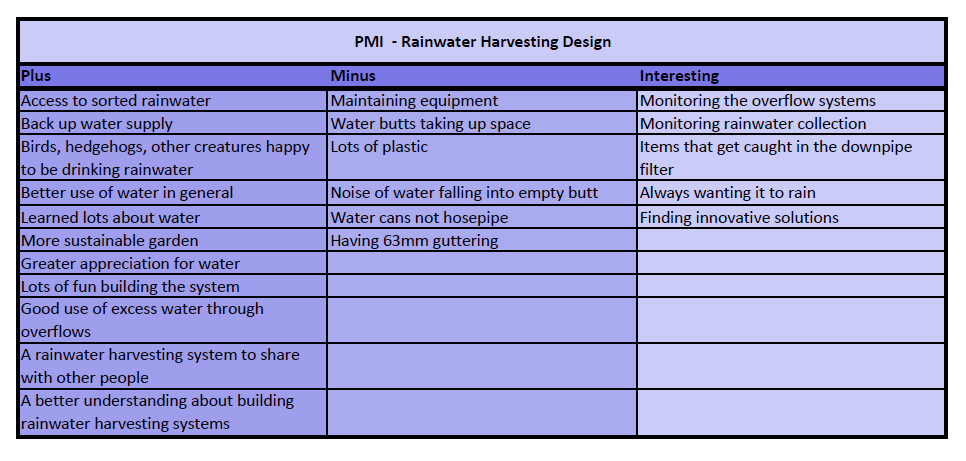Rainwater Harvesting Design – Evaluate


Rainwater Harvesting Systems In Action
The Back Garden
The Front Garden
These two videos show how the rainwater harvesting systems are working after a night of heavy rain. As you will see the overflows in both gardens are working as predicted piping the water into the growing beds. It has taken a few months before we have had enough rain to fill the butts in the front garden so I’m finally happy now that both systems have passed the heavy rain test with the overflows handling the excess rainwater.

Overview
This has been an interesting design to work on, I started it when I concluded early in the redesign of the kitchen garden that I need to put more thought into the composting systems I was running. The kitchen garden design turned into a large design needing lots of focus to stay on track.
There were two areas that I just could not include without making the design into a monster that would end up eating me alive. Water harvesting was the other area that was far too complex to think about.
After mapping out the basics for this soil fertility design I was able to think more logically about the current composting systems than I was doing when they were part of the kitchen garden reloaded design.
In this section of the design process, I will use the PMI design tool to help highlight what has been a plus, a minus, or just interesting in the design. I will follow this with a SWOC report exploring the strengths, weaknesses, opportunities, and challenges.
PMI – Plus Minus Interesting
PMI is a brainstorming, decision making and critical thinking tool. It is used to encourage the examination of ideas, concepts and experiences from more than one perspective. I'm using it here to help me evaluate my design.

I’ve loved every part of this design, from researching how Yorkshire Water provides me with water to how much water has shaped civilizations, the designing a solution to the implementation and running of the system. The above PMI table gives a quick overview of some of the highlights and low points of this design.

SWOC Analysis
SWOC is an acronym for Strengths, Weaknesses, Opportunities, Challenges. Here this is used as a tool to focus on the key areas of the design.
Strengths
Of all my designs this was the most reliant on having the correct equipment, this meant there was a lot of thought that went into how I was to design each of the rainwater harvesting systems. Over the past fifteen years, I’ve watched and read countless accounts of what people have been doing to store water from large-scale sites to small urban gardens. The great thing about permaculture is the creativity of some of the people who are actively practising it when it comes to providing different solutions to the same problem.
It’s taken me longer than I would have liked to set up my rainwater harvesting system but with all the years of research, I had a good foundation to work from. I have also been involved with setting up and running auto watering systems on large rearing fields for game birds in the past so I’m not new to how water acts in different environments.
Water is no different from any caged animal, always looking to escape whenever possible. Buying quality over cost played an important part when selecting the different components to be included in the system. This didn’t mean everything needed to be an off-the-shelf rainwater harvesting system. I’ve bought from car part suppliers, used old food barrels as water butts, and improvised with timber offcuts, and bamboo canes, all adding character to the design.
The implementation of this design has also come at a time when, as I write this in the spring of 2022, I believe both the front and back gardens are now at a stage when I will not be doing any more major design changes that would affect how the rainwater harvesting systems work. The investment in equipment should hold and in the coming years, the returns should outweigh the setup cost.
From the sustainability perspective, my food growing is becoming less reliant on external resources. Having a large supply of harvested rainwater on-site improves the resilience of the garden during drier periods of the year.
Weaknesses
The very morning after finishing the rainwater harvesting system, I was awakened at 1:30 to the very loud sound of water falling into an empty water butt. The noise was never a consideration in this design. The water butts in the back garden are located directly below my bedroom window, as I lay in bed listening to the echo of water falling into the water butt at least I knew the first part of the system was working. Fortunately, or unfortunately, the rain was only short-lived leaving around 20 centimetres of water in the butt.
Once we had more rain and the water butt filled up the noise reduced and is no longer an issue. I’ve also programmed myself to relate the sound of rainwater falling into the water butt with the sound of hitting the jackpot on a slot machine in a Las Vegas, rainwater is money in my bank.
I do need to keep the equipment maintained, mainly I need to keep checking the filters in the downpipe diverters to remove any items that get collected to avoid the downpipe backfilling.
Opportunities
This along with the past two designs the kitchen garden reloaded, and the soil fertility have all been working towards improving the original designs of my gardens that I started back in 2017. Not rushing ahead and setting up a water harvesting system in a half-finished design has allowed me to develop the garden to the point where solid locations have been built for the water butts. By not having anything set up I’ve been able to think about how I would eventually build my water harvesting system and only do it once.
This design has also made me think about water differently. The book Water: A Biography was a good addition to understanding more about how water has impacted civilization. The Yorkshire Water YouTube channel provided a lot of very interesting information about how my tap water is supplied; I’ve added 6 videos in the appendix section that gives a great overview of this process.
I now have a system I can monitor to understand how much water I’m using in the garden, and I also get to monitor the overflows on each of the systems. The back garden overflow has the potential to be redesigned in the third year to utilise excess water more productively.
Challenges
The size of the guttering on the house turned out to be the biggest challenge, the house still has the original guttering that went up in 1980, this is 63mm, and the standard now is 68mm. I could not find any 63mm gutter parts anywhere. The size of the pipe in the diverter is 63mm the same as my downpipe. The challenge was to find something I could use to reduce the 63mm of the diverter to enable it to go inside the downpipe. On my second try at buying something I ended up using a silicone hose part for a car, this was perfect for the job and highly recommend it.
The biggest challenge for this design was understanding how much water I would get and how much water I will use. I would have liked to have said I need this amount of water storage to be able to water my garden throughout the growing season and then use that as a guide to building the system. To balance this unknown out was to add an extra year to the design to be able to reflect after one growing season and tweak the design for additional storage if needed.
The design also involved buying equipment, all of which was going to be plastic of some sort. With a design so equipment heavy I added a short maintenance plan in the idea section to keep the equipment in good working order to prolong its usability.
Conclusion
This has been an enjoyable little design to work on, along with giving me a greater understanding of water.








